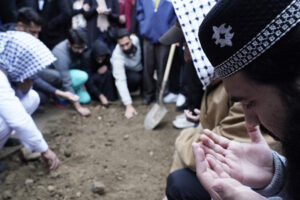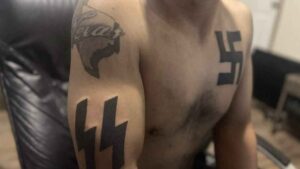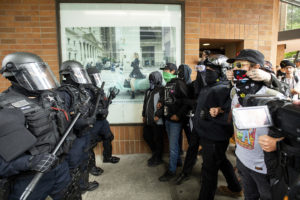This Just In: Islamophobia
The evil side of America is on display in the form of a media-fueled Islamophobia that recalls some of the worst bigotry in the nation’s past. This is not what we hoped for in the days after Sept. 11, 2001, or the election of President Barack Obama in 2008. The evil side of America is on display in the form of a media-fueled Islamophobia that recalls some of the worst bigotry in the nation’s past.
The evil side of America is on display in the form of a media-fueled Islamophobia that recalls some of the worst bigotry in the nation’s past. This is not what we hoped for in the days after Sept. 11, 2001, or the election of President Barack Obama in 2008.
“During Ramadan, I visited 25 communities, 25 mosques, and I have never seen such a high level of anxiety,” said Hussam Ayloush, executive director of the Council on American-Islamic Relations (CAIR) of the Greater Los Angeles Area. “Most Americans don’t realize what it is to be a targeted minority. The overwhelming majority of Americans don’t know what it is to be a victim of hate crimes.”
A Washington Post-ABC News poll indicates his impressions may be correct. Forty-nine percent of those surveyed held an unfavorable view of Islam, compared with 37 percent with a favorable view. In October 2002, 47 percent said their view of Islam was favorable and 39 percent unfavorable. A third in the latest poll, about double the 2002 level, said they believed Islam encourages violence.
I was introduced to Ayloush by the Greater Los Angeles area council’s communication manager, Munira Syeda, who was one of my students during a semester that I taught reporting and column writing at UC Berkeley’s Graduate School of Journalism.
It was the fall semester of 2001. On Tuesday, Sept. 11, I rose early, turned on the television and watched the planes hit the World Trade Center. My class—half a dozen or so students—was to meet at 9 a.m. I didn’t think anyone would show up. But I thought I should check in.
I walked through a deserted campus to my classroom in North Gate Hall. Every one of my students was there. It would have been just as easy—and excusable—for them to stay home and immerse themselves in trauma. But they were ready and eager to get started.
We decided each student would examine the impact of the attack on a minority community in the Bay Area. One student picked the Jewish community. Another chose African-Americans. Munira examined Muslims’ reactions. And one chose the Japanese-American community, whose members had been herded into prison camps after Pearl Harbor was attacked on Dec. 7, 1941. That, we all knew, was the most apt comparison. The question was whether Muslims would be treated as Japanese-Americans were 60 years before.
The young journalists started digging. Although some were on unfamiliar ground, they learned about the people they covered, about their lives, feelings and interests.
Meanwhile, fear subsided, the fear that drove Muslim women students to band together with men for the nighttime walk home from the library. The country slogged through wars, elected an African-American president and congratulated itself on being such a forward-looking and tolerant nation—until the craziness started.
How did it start?
A huge factor was the Great Recession. “Under unusual circumstances, we find someone to blame,” said Ayloush. He noted that anti-Semitism was intense during the Depression, and that Mexicans, including U.S. citizens caught up in the hysteria, were deported. The World War II imprisonment of Japanese-Americans was the most egregious example.
Someone has to fan the bigotry. During the Depression, Father Charles Coughlin attacked the Jews in radio speeches that had a wide audience, playing on the anti-Semitism that was part of American life. The imprisonment of the Japanese was preceded by many years of hostile mainstream news coverage of them, stories in which they were portrayed as lesser human beings. Today, misleading blogs on Muslims appear on the Internet. Several anti-Muslim blogs have fiercely attacked the plans to build a community center and mosque near Ground Zero.
One of the leading blogging opponents of the mosque is Jihad Watch, headed by Robert Spencer. Spencer is the author of 10 books, including “The Truth About Muhammad” and, with Pamela Geller, of “The Post-American Presidency: The Obama Administration’s War on America.”
Some of the anti-mosque bloggers are hawkish supporters of Israel. Politico has reported that Jihad Watch was supported by funds provided by Joyce Chernick, a founder of Pajamas Media, a backer of Israel hard-liners. I find it disgusting that supporters of Israel would take part in such an effort.
Diane Winston, who holds the Knight Chair in Media and Religion at the University of Southern California’s Annenberg School for Communication, told me she believes “the whole notion of Islamophobia is tied to an anti-Obama feeling … it’s not politically correct to say you are anti-black. It’s OK to say you are anti-Muslim. … It’s a foil for racism.”
She also said anti-Muslim sentiment slipped into the mainstream media, especially when news outlets began covering the Manhattan mosque story and the threat by the Rev. Terry Jones and his 50-member Florida congregation to burn the Quran unless the planned mosque was moved.
Winston’s remark made sense to me. The “he said, she said” conventions of traditional journalism require that one statement be balanced by another, no matter how loony. As a result, Jones emerged last week as a theological source, worthy of equal time to balance the conciliating words of President Barack Obama and other sensible people. Jones has now abandoned his Quran-burning project, and the media, with its short attention span, will move on to someone else, some other crazy to “balance” the words of the sane.
Today, Muslims are covered as if they were “the other,” a subset outside American life. Why don’t mainstream reporters learn about the Muslim community and report on the daily lives of men, women and young people? What about the writers, the nurses, the athletes, the doctors, the lawyers, the professors, the small business owners, the working-class men and women who are struggling with the sick economy? What about the men and women in the armed forces?
My students found such regular people, including American Muslims, who live their lives just as most people do. It’s hard to believe that the traditional media couldn’t do the same.
Your support matters…Independent journalism is under threat and overshadowed by heavily funded mainstream media.
You can help level the playing field. Become a member.
Your tax-deductible contribution keeps us digging beneath the headlines to give you thought-provoking, investigative reporting and analysis that unearths what's really happening- without compromise.
Give today to support our courageous, independent journalists.






You need to be a supporter to comment.
There are currently no responses to this article.
Be the first to respond.